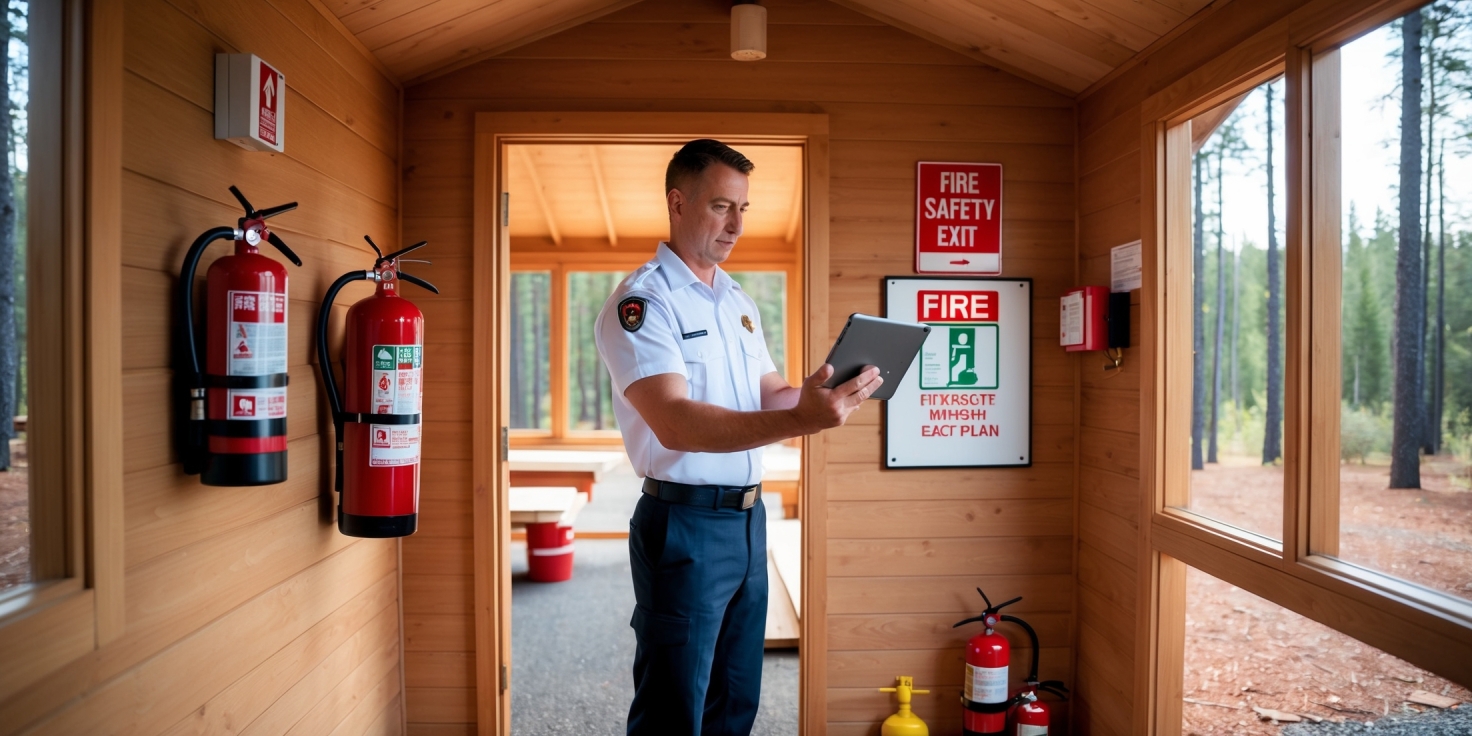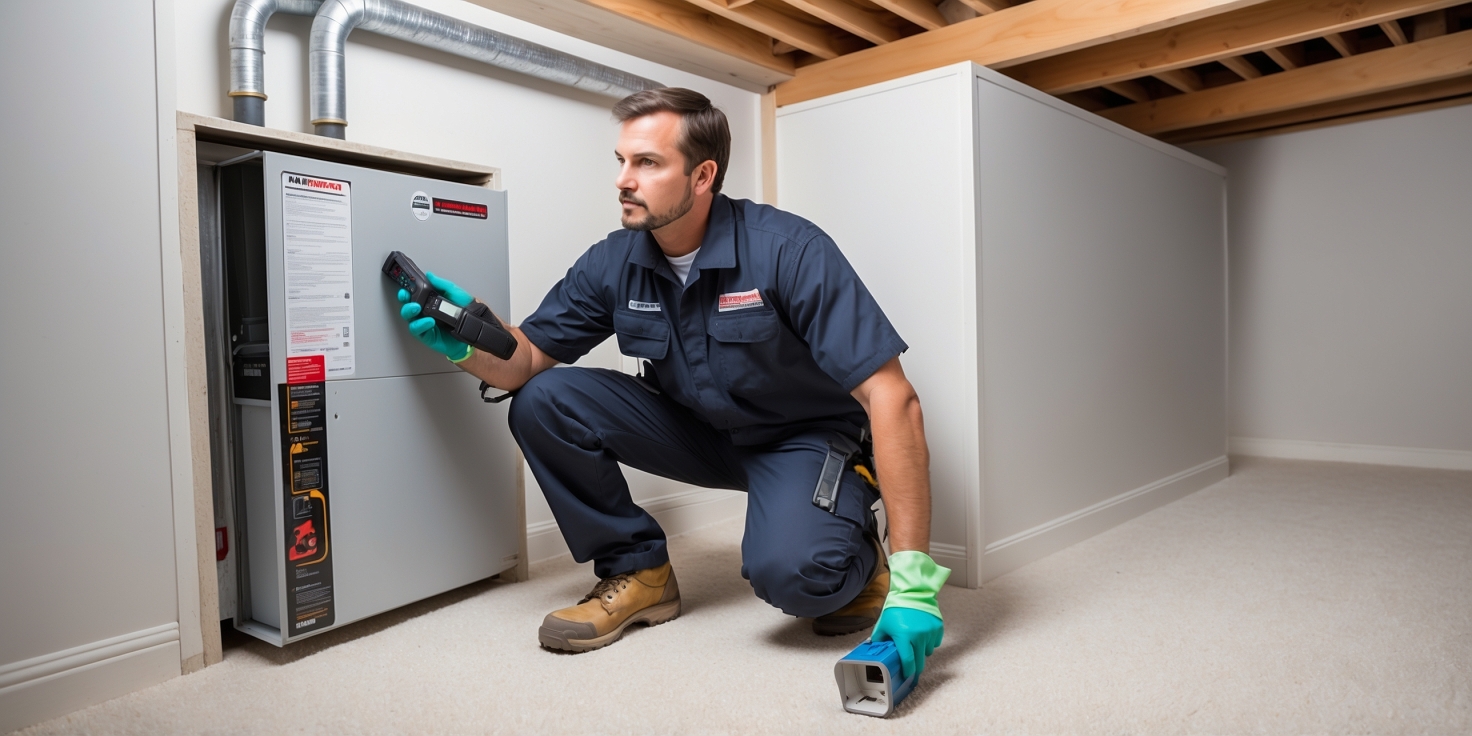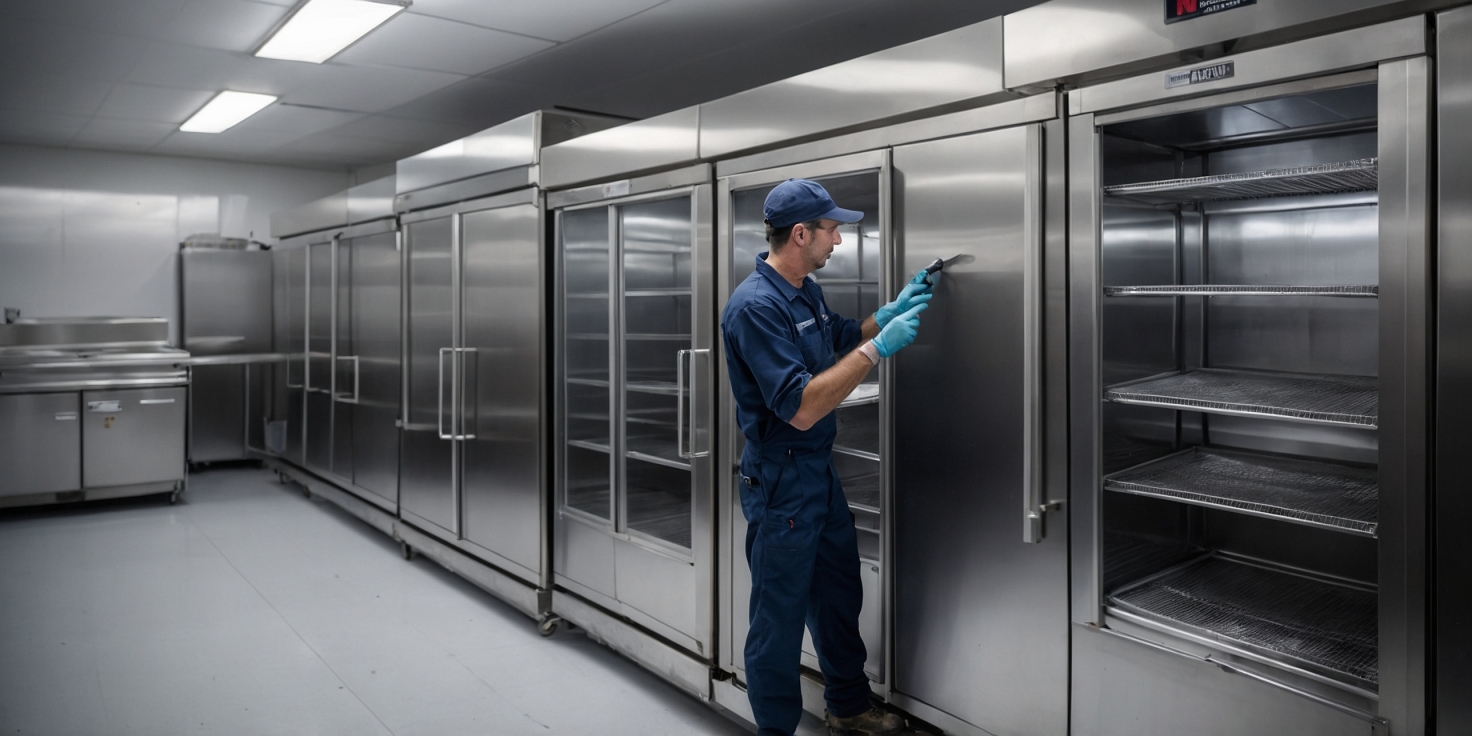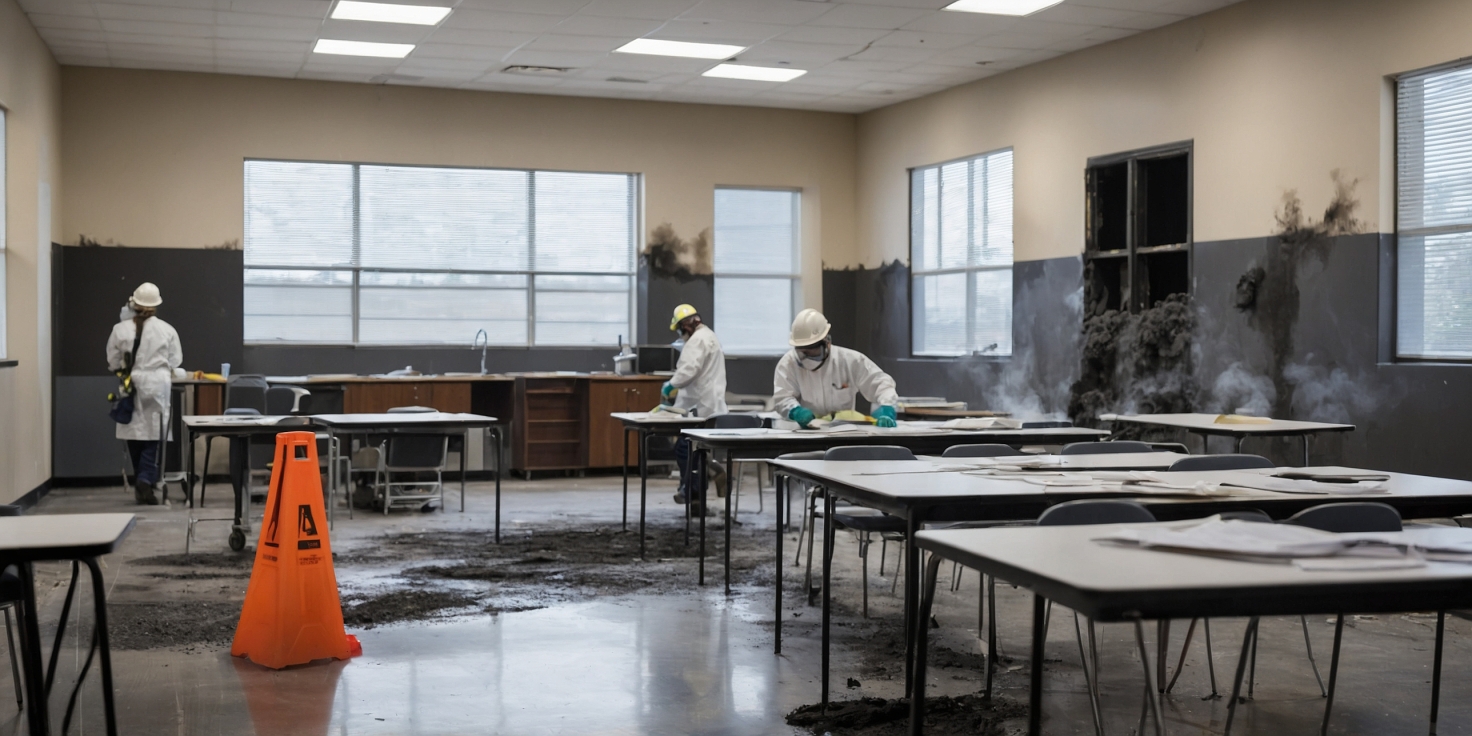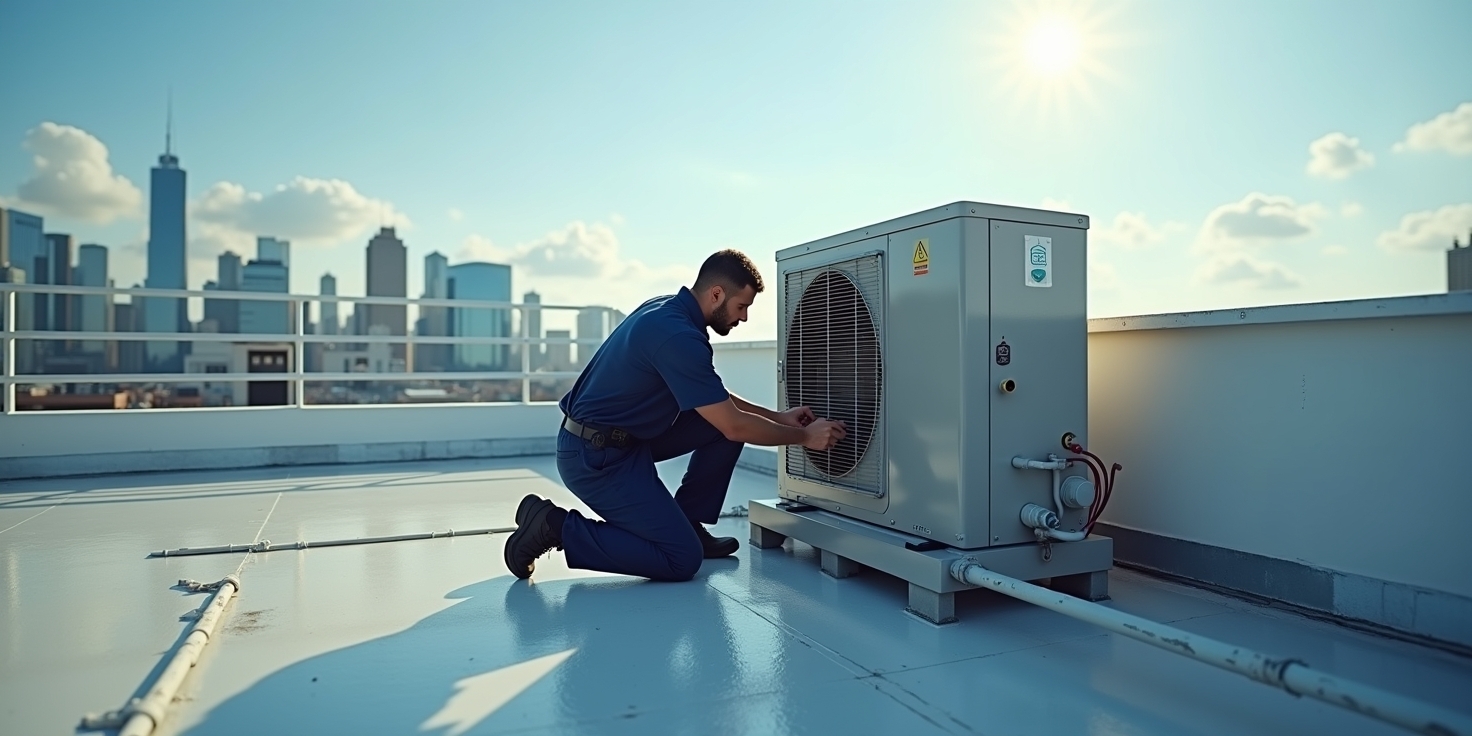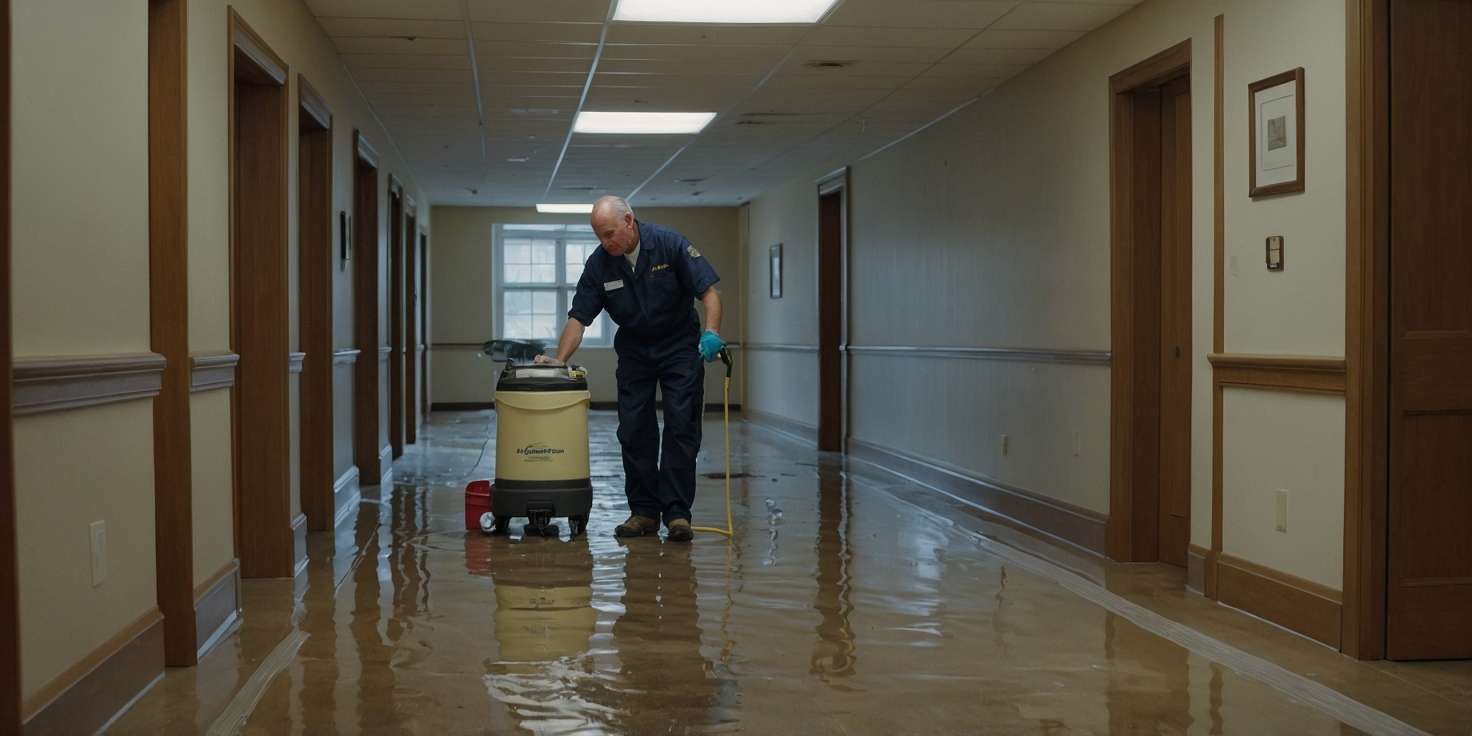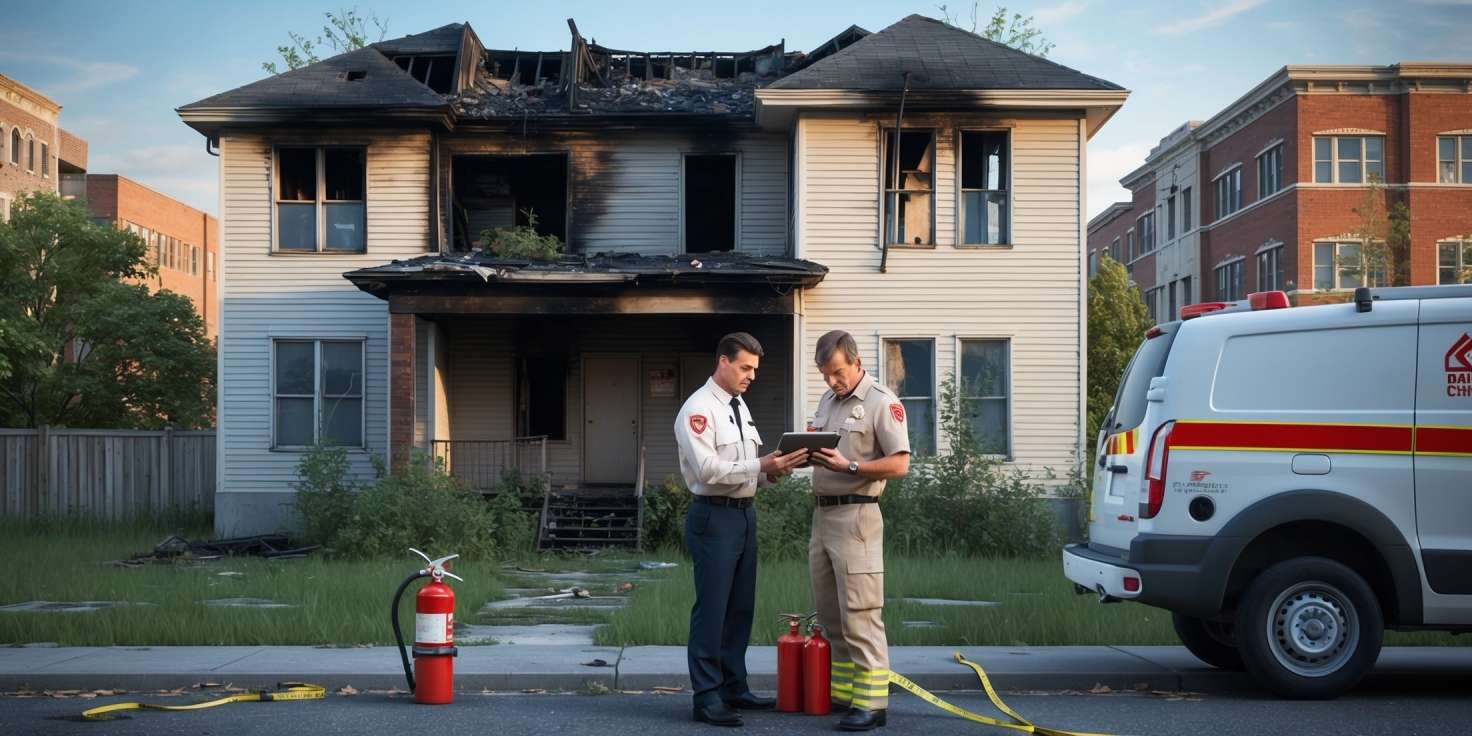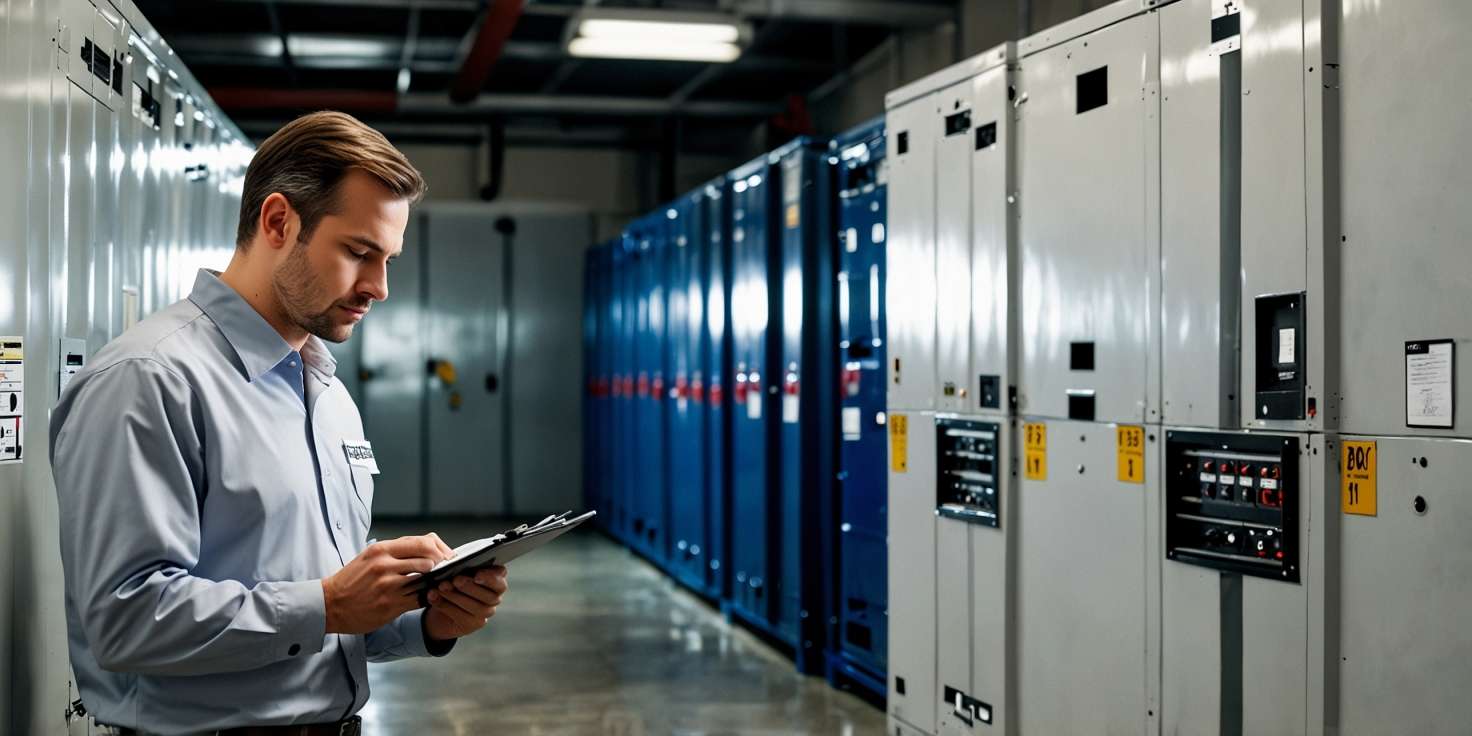Mold growth in commercial storage units can lead to serious damage, costly repairs, and potential health risks. Whether you’re storing important documents, inventory, or equipment, knowing how to prevent mold in commercial storage units is essential for maintaining a clean and safe environment. At COMMITTED TO QUALITY SERVICE, we understand the importance of protecting your assets. Our team offers fast, friendly, and professional service, specializing in water damage restoration and fire damage recovery. With the right preventative measures—such as controlling humidity, ensuring proper ventilation, and addressing water leaks promptly—you can significantly reduce the risk of mold. If your storage facility has experienced water damage, our expert technicians use advanced equipment to dry and restore affected areas efficiently. Call us now at 855-933-7935 to learn more about our comprehensive mold prevention and restoration services.
Understand the Causes of Mold Growth
Mold growth in commercial storage units is a common yet often overlooked issue that can lead to significant property damage, health risks, and financial losses. Understanding the root causes of mold is essential for implementing effective prevention strategies. Mold is a type of fungus that thrives in moist, warm, and poorly ventilated environments. It reproduces through microscopic spores that are present in the air and can settle on various surfaces. When these spores find the right conditions—typically moisture, organic material, and the right temperature—they begin to grow and spread rapidly. This makes commercial storage units, which often lack proper airflow and may contain organic materials like cardboard, wood, or fabric, particularly vulnerable.
One of the primary causes of mold in storage units is excess moisture. Moisture can enter a storage unit in several ways, including leaks in the roof or walls, condensation due to temperature fluctuations, or high humidity levels. According to the Environmental Protection Agency (EPA), indoor relative humidity should be kept below 60 percent—ideally between 30 and 50 percent—to prevent mold growth. When humidity levels rise above this threshold, the risk of mold increases significantly. This is especially true in regions with humid climates or during rainy seasons when moisture intrusion is more likely.
Another major contributor to mold growth is poor ventilation. Without adequate airflow, moisture becomes trapped inside the unit, creating a damp environment that is ideal for mold development. Many commercial storage units are sealed tightly to protect stored items from external elements, but this can inadvertently lead to stagnant air and increased humidity. Installing proper ventilation systems or using dehumidifiers can help mitigate this risk by promoting air circulation and reducing moisture levels.
Temperature also plays a crucial role in mold proliferation. Mold tends to grow best in temperatures between 77 and 86 degrees Fahrenheit, although some species can thrive in colder or warmer conditions. Storage units that are not climate-controlled may experience significant temperature fluctuations, especially in areas with extreme weather conditions. These fluctuations can lead to condensation on walls, ceilings, and stored items, further contributing to mold growth.
The materials stored within the unit can also influence mold development. Organic materials such as paper, cardboard, wood, and textiles are particularly susceptible to mold when exposed to moisture. These materials not only provide a food source for mold but also absorb and retain moisture, creating a self-sustaining environment for fungal growth. It is essential to store items in plastic containers with tight-fitting lids and to avoid placing items directly on the floor, where they are more likely to come into contact with moisture.
Water damage is another significant factor that can lead to mold in commercial storage units. Leaks from plumbing systems, roof damage, or flooding can introduce large amounts of water into a unit, creating the perfect breeding ground for mold. Even small leaks, if left unaddressed, can result in mold infestations over time. According to the Federal Emergency Management Agency (FEMA), mold can begin to grow within 24 to 48 hours after water exposure. This highlights the importance of prompt water damage restoration and regular inspections to detect and repair leaks early. For more information on how to address water-related issues, visit our water damage page.
In addition to environmental factors, human behavior can also contribute to mold growth. Improperly stored items, such as wet or damp belongings, can introduce moisture into the unit. Failing to clean and dry items before storage, or placing them in sealed containers while still damp, can create localized pockets of humidity that encourage mold development. It is crucial to ensure that all items are thoroughly dried and cleaned before being placed in storage.
To illustrate the various causes of mold growth, consider the following examples:
- A storage facility in a coastal area experiences high humidity levels year-round. Without dehumidifiers or climate control, moisture accumulates inside the units, leading to widespread mold issues.
- A tenant stores cardboard boxes directly on the concrete floor of a unit. During a rainy season, water seeps through the floor, saturating the boxes and causing mold to grow on the contents.
- A leaking pipe in the ceiling of a storage unit goes unnoticed for several weeks. The constant drip creates a damp environment, resulting in mold growth on stored furniture and fabrics.
"Mold can start growing within 24 to 48 hours of water exposure, making early detection and prevention critical." — FEMA
To prevent mold, it is essential to understand these underlying causes and take proactive measures. Regular inspections, proper ventilation, climate control, and careful storage practices can significantly reduce the risk of mold in commercial storage units. Additionally, investing in professional mold remediation services can help address existing issues and prevent future outbreaks. Learn more about our expert solutions by visiting our mold remediation page.
For those seeking more information on how to identify early signs of water damage, which often precedes mold growth, our detailed guide on how to identify hidden water damage early offers valuable insights. Understanding these signs can help facility managers and tenants take timely action to prevent mold before it becomes a serious problem.
In conclusion, mold growth in commercial storage units is primarily driven by moisture, poor ventilation, temperature fluctuations, and the presence of organic materials. By recognizing these factors and implementing preventive measures, property owners and tenants can protect their belongings and maintain a safe, mold-free environment. For more information about our company and our commitment to quality service, visit our about page.
Choose the Right Location for Your Storage Unit
When it comes to preventing mold in commercial storage units, one of the most critical yet often overlooked factors is the location of the storage facility. The geographical and environmental conditions of a storage unit’s location can significantly influence the likelihood of mold growth. Choosing the right location is not just about convenience or cost; it is about ensuring that your stored items remain safe, dry, and mold-free over time. Mold thrives in damp, humid environments, so selecting a storage unit in an area with low humidity and minimal exposure to water-related risks is essential. For instance, avoid facilities located in flood-prone zones, near large bodies of water, or in regions with consistently high humidity levels. These areas are more susceptible to moisture intrusion, which can create the perfect breeding ground for mold spores.
Another important consideration is the elevation of the storage facility. Units located at or below ground level are more likely to experience water seepage, especially during heavy rains or snow melts. Opting for a facility that is elevated or has proper drainage systems in place can significantly reduce the risk of water accumulation and subsequent mold growth. Additionally, the construction and maintenance of the building itself play a vital role. Look for facilities that are well-maintained, with no visible signs of water damage, leaks, or structural issues. A well-constructed facility with proper insulation and ventilation will help regulate temperature and humidity levels, making it less conducive to mold development.
Proximity to your business or operational hub is also a factor to consider, but it should not outweigh the importance of environmental safety. While it may be tempting to choose a nearby facility for convenience, it is more important to ensure that the location supports long-term preservation of your stored items. Take the time to research the facility’s history and reputation. Ask about any past incidents of water damage or mold issues and inquire about the preventive measures they have in place. Visiting the site in person can provide valuable insights into its condition and suitability for your storage needs.
Moreover, consider the climate control options available at the facility. A location that offers climate-controlled units can be a game-changer in mold prevention. These units maintain consistent temperature and humidity levels, which are crucial in preventing moisture buildup. Even in areas with fluctuating weather conditions, a climate-controlled environment can provide a stable setting that protects your items from mold and mildew. It is also beneficial to choose a facility that conducts regular inspections and maintenance. Routine checks for leaks, ventilation issues, and signs of mold can help catch problems early before they escalate.
Accessibility and security are additional factors that indirectly impact mold prevention. A secure facility with controlled access reduces the chances of unauthorized entry, which can lead to accidental damage or exposure to moisture. Furthermore, easy access allows you to regularly inspect your unit and ensure that everything remains in good condition. Regular visits enable you to spot early signs of mold or moisture and take corrective action promptly.
Incorporating professional guidance can also be a wise decision when selecting a storage location. Consulting with experts in property restoration and mold prevention can provide you with tailored advice based on your specific needs and the nature of the items you plan to store. For more information about how professionals can assist in maintaining a mold-free environment, you can explore our services page. Additionally, understanding the broader scope of our work and commitment to quality can be found on our about page.
Ultimately, the right location for your commercial storage unit is one that combines environmental safety, structural integrity, and proactive maintenance. By prioritizing these factors, you can significantly reduce the risk of mold and ensure that your stored items remain in excellent condition. Taking the time to evaluate and choose the best possible location is a proactive step that pays off in the long run, protecting your investments and giving you peace of mind.
Inspect Units Regularly for Signs of Moisture
One of the most effective ways to prevent mold growth in commercial storage units is through consistent and thorough inspections for any signs of moisture. Mold thrives in damp, humid environments, and even a small amount of unnoticed moisture can lead to significant mold problems over time. Regular inspections help identify early warning signs such as condensation on walls or ceilings, musty odors, water stains, or visible mold spots. These checks should be conducted routinely, especially after heavy rainfall, high humidity periods, or any incidents involving water leaks. It’s essential to examine not only the visible areas but also hidden corners, behind stored items, and around HVAC systems or plumbing fixtures where moisture can accumulate unnoticed. Early detection allows for prompt action, such as drying out affected areas, repairing leaks, or improving ventilation, which can significantly reduce the risk of mold development. For businesses managing multiple units, creating a checklist and schedule for inspections can streamline the process and ensure no area is overlooked. Additionally, educating staff on what to look for during inspections can enhance the effectiveness of these efforts. If signs of moisture or mold are found, it’s crucial to act quickly and consult professionals who specialize in mold remediation to assess and address the issue properly. Understanding the importance of moisture control is part of a broader strategy to maintain a clean and safe storage environment. For more information on how moisture can lead to hidden damage, visit our guide on how to identify hidden water damage early. Regular inspections not only protect stored goods but also preserve the structural integrity of the facility, ensuring long-term usability and customer satisfaction.
Control Humidity Levels Inside the Unit
Maintaining optimal humidity levels is one of the most effective strategies to prevent mold growth in commercial storage units. Mold thrives in environments where moisture levels are consistently high, typically above 60 percent relative humidity. Therefore, controlling humidity is not just a preventative measure but a necessity for preserving the integrity of stored items and ensuring a safe, mold-free environment. Commercial storage units often house valuable inventory, documents, equipment, or furniture, all of which can be severely damaged by mold. By implementing proper humidity control methods, business owners can protect their assets and avoid costly remediation efforts.
The first step in managing humidity is to understand the climate and environmental conditions of the storage facility. In regions with high ambient humidity, storage units are more susceptible to moisture accumulation. Even in drier climates, fluctuations in temperature can cause condensation, especially in poorly insulated units. To combat this, it is essential to install a reliable HVAC system that includes dehumidification capabilities. These systems help regulate both temperature and humidity, creating a stable environment that discourages mold growth. Regular maintenance of HVAC systems is also crucial to ensure they function efficiently and do not become sources of moisture themselves.
Another effective method to control humidity is the use of standalone dehumidifiers. These devices are particularly useful in units that store sensitive materials or in facilities without central climate control. Dehumidifiers should be appropriately sized for the space and monitored regularly to ensure they are operating effectively. Some advanced models come with hygrometers that provide real-time humidity readings, allowing for precise adjustments. It is advisable to keep humidity levels between 30 and 50 percent to minimize the risk of mold development.
Proper ventilation is equally important in maintaining low humidity levels. Storage units should be designed or retrofitted to allow for adequate air circulation. This can be achieved through the installation of vents, exhaust fans, or even by periodically opening the unit to allow fresh air to enter. Good airflow helps disperse moisture and prevents it from settling on surfaces where mold spores can take hold. For larger commercial storage facilities, implementing a mechanical ventilation system may be necessary to ensure consistent air exchange throughout the space.
Moisture barriers and insulation also play a significant role in humidity control. Walls, floors, and ceilings should be sealed with vapor barriers to prevent moisture intrusion from the outside. Insulation helps maintain a consistent internal temperature, reducing the likelihood of condensation forming on surfaces. Additionally, using moisture-absorbing materials such as silica gel packets or desiccant dehumidifiers inside the unit can provide an extra layer of protection, especially in smaller or enclosed spaces.
Regular inspections and maintenance are key to identifying and addressing potential humidity issues before they lead to mold growth. Facility managers should routinely check for signs of water intrusion, such as damp spots, condensation, or musty odors. Monitoring tools like digital hygrometers can be installed to provide continuous data on humidity levels, enabling prompt corrective action when necessary. If any signs of mold or excessive moisture are detected, it is crucial to act quickly to mitigate the problem and prevent it from spreading.
In addition to mechanical solutions, the way items are stored can influence humidity levels. Avoid placing items directly against walls or on the floor, as this can restrict airflow and trap moisture. Instead, use shelving units to elevate items and allow air to circulate freely around them. Choose storage containers made of plastic with tight-fitting lids rather than cardboard, which can absorb moisture and become a breeding ground for mold. Labeling and organizing items can also make it easier to conduct regular inspections and spot any early signs of moisture damage.
For businesses that require professional assistance in managing humidity and preventing mold, working with a trusted restoration company can be invaluable. At Projekt Restoration, we offer comprehensive solutions tailored to the unique needs of commercial storage facilities. Our team of experts can assess your unit, recommend appropriate humidity control measures, and provide ongoing support to ensure a mold-free environment. Whether you are dealing with existing mold issues or looking to implement preventative strategies, our services are designed to deliver peace of mind and long-term protection.
Understanding the science behind humidity and mold growth is essential for effective prevention. Mold spores are naturally present in the air, but they require moisture to grow and spread. By eliminating excess humidity, you remove one of the critical elements mold needs to thrive. This proactive approach not only safeguards your stored items but also contributes to a healthier indoor environment, reducing the risk of respiratory issues and other health problems associated with mold exposure.
If you are unsure about the current condition of your storage unit or need guidance on best practices, our team is here to help. Visit our contact page to get in touch with our specialists and schedule a consultation. We are committed to helping businesses maintain clean, safe, and efficient storage environments through expert advice and professional services.
In conclusion, controlling humidity levels inside commercial storage units is a fundamental aspect of mold prevention. Through a combination of climate control systems, dehumidifiers, proper ventilation, insulation, and smart storage practices, business owners can significantly reduce the risk of mold damage. Regular monitoring and maintenance further enhance these efforts, ensuring that any potential issues are addressed promptly. By taking these proactive steps, you not only protect your assets but also create a more reliable and professional storage solution for your business needs.
Use Mold-Resistant Materials and Products
One of the most effective strategies for preventing mold in commercial storage units is the use of mold-resistant materials and products during construction, renovation, or maintenance. Mold thrives in environments where moisture is present and organic materials like wood, drywall, or fabric provide a food source. By incorporating materials specifically designed to resist mold growth, you can significantly reduce the risk of contamination and protect the integrity of stored items. Mold-resistant drywall, for example, is treated with fiberglass instead of paper facing, which makes it less susceptible to moisture absorption and mold colonization. Similarly, mold-resistant insulation, such as closed-cell spray foam, not only provides thermal efficiency but also acts as a barrier against moisture intrusion.
Flooring choices also play a crucial role in mold prevention. Opting for non-porous materials like sealed concrete, vinyl, or ceramic tiles can help prevent moisture from seeping in and creating a breeding ground for mold. These materials are easier to clean and maintain, making them ideal for high-traffic commercial storage environments. Additionally, using mold-resistant paint on walls and ceilings adds another layer of protection. These paints contain antimicrobial agents that inhibit mold growth, especially in areas prone to high humidity.
Ventilation and air circulation are equally important when using mold-resistant materials. Even the most advanced products can fail if the environment remains damp and poorly ventilated. Installing dehumidifiers and ensuring proper HVAC maintenance can complement the use of mold-resistant materials by keeping humidity levels in check. For storage units located in flood-prone or high-humidity areas, it’s advisable to install vapor barriers and moisture-resistant wall panels to further safeguard against mold.
When selecting mold-resistant products, it’s essential to consult with professionals who understand the unique needs of commercial storage facilities. Working with experts ensures that the right materials are chosen and installed correctly. For more information about the services available to help protect your facility, visit our services page. You can also learn more about our team and their expertise by exploring the about section.
Incorporating mold-resistant materials is not just a preventive measure but a long-term investment in the safety and durability of your commercial storage unit. It minimizes the risk of costly mold remediation, protects valuable inventory, and ensures a healthier environment for employees and clients. By taking proactive steps and using the right materials, you can maintain a mold-free facility that stands the test of time.
Ensure Proper Ventilation Throughout the Facility
Maintaining adequate airflow is one of the most effective strategies for preventing mold growth in commercial storage units. Mold thrives in environments with high humidity and stagnant air, making proper ventilation a critical component in mold prevention. When air circulates freely throughout a facility, it helps regulate temperature and moisture levels, reducing the likelihood of condensation and dampness—two key contributors to mold development. Commercial storage units often house a variety of items, including paper documents, electronics, textiles, and furniture, all of which are susceptible to mold damage if exposed to prolonged moisture. By ensuring that air can move consistently throughout the space, you create an environment that is less hospitable to mold spores.
There are several practical steps facility managers can take to improve ventilation. Installing exhaust fans, especially in areas prone to moisture buildup such as basements or corners of large storage rooms, can significantly enhance air exchange. These fans help remove humid air and replace it with drier, fresh air from outside. Additionally, using dehumidifiers in conjunction with fans can further reduce indoor humidity levels, especially in climates where moisture is a persistent issue. For larger facilities, incorporating a mechanical ventilation system that includes air ducts and vents strategically placed throughout the unit can ensure even distribution of airflow. Regular maintenance of HVAC systems is also essential, as clogged filters and dirty ducts can impede airflow and contribute to moisture retention.
Natural ventilation methods should not be overlooked either. Whenever possible, opening windows and doors during dry weather can allow fresh air to circulate and help dry out any damp areas. However, this should be done cautiously to avoid introducing outdoor humidity into the space. Monitoring tools such as hygrometers can be used to track humidity levels and ensure they remain below 60 percent, which is generally considered safe for mold prevention. In addition, facility managers should conduct routine inspections to identify any areas where air circulation is poor or where moisture tends to accumulate. These inspections can help catch potential problems early, allowing for timely intervention before mold has a chance to develop.
Another important consideration is the layout of the storage unit itself. Overcrowding can restrict airflow and create pockets of stagnant air where mold can flourish. Items should be stored with adequate spacing between them and away from walls to allow air to circulate freely. Using shelving units instead of stacking boxes directly on the floor can also improve airflow and reduce the risk of moisture buildup. Furthermore, choosing storage materials that are less prone to absorbing moisture, such as plastic bins with tight-fitting lids, can offer an added layer of protection against mold.
Incorporating mold-resistant building materials during construction or renovation can also support better ventilation and moisture control. Materials like mold-resistant drywall, paint, and insulation can help reduce the risk of mold growth, especially in areas that are difficult to ventilate adequately. Facility managers should also consider sealing any cracks or gaps in walls, ceilings, and floors that might allow moisture to seep in and compromise the indoor air quality. Sealing these entry points not only helps maintain a consistent indoor environment but also supports the overall effectiveness of the ventilation system.
In the event that mold is already present or suspected, it is crucial to address the issue promptly and professionally. Mold remediation experts can assess the extent of the problem and implement targeted solutions to eliminate mold and prevent its recurrence. For more information on professional mold removal and prevention services, visit our mold remediation page. Additionally, understanding the underlying causes of mold, such as hidden water leaks or poor ventilation, can help prevent future outbreaks. You can learn more about identifying early signs of water damage by visiting our guide on how to identify hidden water damage early.
Ultimately, ensuring proper ventilation is not just about comfort—it is a proactive measure that protects the integrity of stored items and the health of individuals who access the facility. By implementing a comprehensive ventilation strategy that includes mechanical systems, natural airflow, regular maintenance, and thoughtful storage practices, commercial storage unit operators can significantly reduce the risk of mold growth. This approach not only preserves the value of stored goods but also contributes to a cleaner, safer, and more efficient storage environment.
Keep Stored Items Clean and Dry
One of the most effective ways to prevent mold growth in commercial storage units is by ensuring that all stored items are clean and completely dry before placing them into storage. Mold thrives in damp, organic materials, so even a small amount of moisture or organic residue can create the perfect environment for mold spores to settle and multiply. Before storing any items, especially textiles, furniture, paper products, or electronics, it is crucial to clean them thoroughly to remove dust, dirt, and any organic matter. For example, upholstered furniture should be vacuumed and, if necessary, professionally cleaned to eliminate any lingering moisture or contaminants. Similarly, clothing and linens should be washed and completely dried before packing. Using airtight plastic containers or vacuum-sealed bags can also help protect sensitive items from humidity and airborne mold spores.
In addition to cleaning, drying items thoroughly is essential. Even a slightly damp item can raise the humidity level inside a storage unit, creating a microclimate conducive to mold growth. This is particularly important for items that may have been exposed to water or high humidity prior to storage. If you are unsure whether an item is fully dry, it is best to let it air out in a well-ventilated area for an extended period before storing it. For businesses that frequently store inventory or equipment, implementing a standard operating procedure for cleaning and drying items before storage can significantly reduce the risk of mold contamination.
Proper packing materials also play a vital role in keeping stored items dry. Avoid using cardboard boxes for long-term storage, especially in areas prone to humidity, as cardboard can absorb moisture and become a breeding ground for mold. Instead, opt for plastic bins with tight-fitting lids. Desiccant packets or moisture absorbers can be placed inside containers to help control humidity levels. Additionally, avoid stacking items directly against walls or on the floor of the storage unit. Elevating items on pallets or shelves allows for better air circulation and reduces the risk of moisture transfer from the ground or walls.
Regular inspections of stored items can help catch early signs of mold before it spreads. Look for musty odors, discoloration, or visible mold spots, and take immediate action if any of these signs are present. If mold is detected, it is advisable to consult with professionals who specialize in mold remediation to ensure safe and effective removal. Businesses that store high-value or sensitive items may also benefit from climate-controlled storage units, which maintain consistent temperature and humidity levels to further protect against mold.
For those seeking more information about best practices in storage and mold prevention, exploring the blog section of our website can provide valuable insights. Additionally, understanding the broader scope of our services can help you identify other areas where mold prevention strategies can be applied, especially if your business has previously experienced water damage or other environmental challenges. Taking proactive steps to keep stored items clean and dry is not just about preserving inventory—it is a critical component of maintaining a healthy, mold-free commercial environment.
Avoid Storing Organic Materials Without Protection
Organic materials such as paper, cardboard, fabric, leather, and untreated wood are highly susceptible to mold growth when stored in commercial storage units without proper protection. These materials naturally absorb moisture from the air, creating an ideal environment for mold spores to thrive. When left unprotected, even a slight increase in humidity or a minor water leak can lead to significant mold infestations, which not only damage the stored items but also compromise the air quality within the storage unit. To prevent this, it is essential to store organic materials in airtight plastic containers or vacuum-sealed bags that act as a barrier against moisture. Additionally, using desiccants like silica gel packets inside containers can help absorb excess humidity and further reduce the risk of mold development.
Another critical step is to ensure that the storage unit itself maintains a stable, low-humidity environment. Investing in climate-controlled storage units can make a significant difference, especially in regions with high humidity or frequent weather fluctuations. Regular inspections of stored items and the unit’s interior can help detect early signs of moisture or mold, allowing for prompt intervention. If you notice any musty odors or visible mold spots, it is crucial to act immediately to prevent the spread of mold to other items. In such cases, professional assistance may be necessary. For more information on how to handle mold issues effectively, consider exploring our mold remediation services.
It is also important to understand the types of materials that are most vulnerable to mold and how to treat them before storage. For example, clothing and textiles should be thoroughly cleaned and completely dried before being packed away. Leather goods benefit from conditioning treatments that help repel moisture. Paper documents and books should be stored in archival-quality containers that offer both physical and environmental protection. If you are unsure about the best practices for storing specific organic materials, our team is here to help. Visit our contact page to get in touch with our experts for personalized advice.
Preventing mold in commercial storage units requires a proactive approach and attention to detail. By taking the time to properly protect organic materials before storage, you can avoid costly damage and ensure that your belongings remain in excellent condition. For a deeper understanding of how moisture can affect your storage environment and how to detect it early, check out our guide on how to identify hidden water damage early. With the right precautions and support, you can maintain a clean, mold-free storage space that preserves the integrity of your stored items.
Seal Cracks and Gaps to Prevent Water Intrusion
One of the most effective ways to prevent mold growth in commercial storage units is by thoroughly sealing all cracks and gaps that could allow water intrusion. Water is the primary catalyst for mold development, and even minor leaks or moisture seepage can create the perfect environment for mold spores to thrive. Over time, small openings in walls, ceilings, floors, or around windows and doors can allow rainwater, humidity, or condensation to enter the unit. This moisture can accumulate in hidden areas, making it difficult to detect until mold has already begun to spread. To avoid this, it is essential to conduct regular inspections of the entire storage facility, paying close attention to structural joints, plumbing fixtures, and any areas where different building materials meet. Use high-quality sealants, caulking, or weather stripping to close off these vulnerable points. Additionally, ensure that the building’s exterior is properly maintained, including the roof, gutters, and drainage systems, to direct water away from the structure. Investing in professional waterproofing services can also be a proactive step to safeguard your storage units. If you are unsure where to start, consider consulting with experts who specialize in restoration services to assess and reinforce your facility’s defenses against water intrusion. Sealing cracks and gaps not only prevents mold but also enhances the overall durability and energy efficiency of the building. For more information on how to protect your property from water-related issues, visit our detailed guide on identifying hidden water damage early. Taking these preventative measures now can save you from costly repairs and health hazards in the future.
Install Dehumidifiers or Moisture Absorbers
One of the most effective ways to prevent mold growth in commercial storage units is by managing indoor humidity levels. Mold thrives in damp, humid environments, and without proper moisture control, even the cleanest storage units can become breeding grounds for mold spores. Installing dehumidifiers or using moisture absorbers is a proactive solution that helps maintain optimal humidity levels, typically between 30 to 50 percent, which is considered safe to inhibit mold development. Dehumidifiers work by extracting excess moisture from the air, thereby reducing the chances of condensation forming on walls, floors, and stored items. This is particularly important in regions with high humidity or during rainy seasons when moisture levels naturally rise. For storage units that house sensitive materials such as paper documents, electronics, or textiles, maintaining a dry environment is crucial to preserving their integrity and value.
Moisture absorbers, such as silica gel packs, calcium chloride containers, or activated charcoal, offer a more passive yet effective method of moisture control. These are especially useful in smaller storage spaces or in areas where installing a full-scale dehumidifier may not be feasible. They are easy to place in corners, on shelves, or inside boxes, and they work silently to capture airborne moisture. Regularly replacing or recharging these absorbers ensures they remain effective over time. For larger commercial storage units, industrial-grade dehumidifiers may be necessary. These units are designed to handle higher volumes of air and can operate continuously, making them ideal for facilities that store large quantities of goods or operate in climates with persistent humidity.
In addition to installing dehumidifiers or using moisture absorbers, it is essential to monitor humidity levels consistently. Hygrometers can be placed throughout the storage unit to provide real-time data on moisture levels, allowing for timely adjustments. Some advanced dehumidifiers come with built-in hygrometers and automatic shut-off features, which help maintain consistent humidity without manual intervention. Integrating these tools into your storage unit management plan not only prevents mold but also extends the lifespan of stored items and reduces the need for costly remediation efforts.
It is also important to consider the layout and ventilation of the storage unit. Proper air circulation complements the function of dehumidifiers and moisture absorbers by ensuring that no area becomes a moisture trap. Strategically placing fans or ensuring that vents are unobstructed can enhance airflow and further reduce the risk of mold. For businesses that manage multiple storage units, implementing a centralized humidity control system can streamline maintenance and ensure uniform protection across all units.
Choosing the right type of dehumidifier or moisture absorber depends on several factors, including the size of the storage unit, the type of materials stored, and the local climate. Consulting with professionals who specialize in environmental control and mold prevention can help you select the most effective solution for your specific needs. At Projekt Restoration, we offer a range of services designed to protect your commercial property from moisture-related damage. Whether you need help selecting the right equipment or require a full assessment of your storage facility, our team is here to assist.
Preventing mold is not just about reacting to visible signs of damage; it is about implementing long-term strategies that address the root causes of moisture buildup. By incorporating dehumidifiers and moisture absorbers into your storage unit maintenance plan, you take a significant step toward safeguarding your assets and maintaining a healthy environment. For more information about our approach and commitment to quality, visit our our mission page. If you have questions about how to get started or need guidance on best practices, our FAQ section provides helpful insights.
Train Staff on Mold Prevention Practices
Proper staff training is a critical component in preventing mold growth in commercial storage units. Employees who are well-informed about mold prevention practices can significantly reduce the risk of contamination and damage to stored goods. The first step in effective training is educating staff on the causes and signs of mold. Mold thrives in environments with excess moisture, poor ventilation, and organic materials to feed on. Employees should be trained to recognize early indicators such as musty odors, discoloration on walls or stored items, and condensation on surfaces. Understanding these warning signs allows for early intervention, which is essential in preventing mold from spreading.
In addition to identifying mold, staff should be trained on proper cleaning and maintenance routines. Regular inspections of the storage facility should be part of their responsibilities, with a focus on checking for leaks, water stains, and humidity levels. Employees should know how to use moisture meters and dehumidifiers effectively, ensuring that the environment remains dry and inhospitable to mold. Training should also cover the importance of keeping storage units clean and clutter-free, as accumulated dust and debris can trap moisture and create ideal conditions for mold growth.
Another key aspect of staff training is understanding the importance of proper ventilation. Employees should be instructed on how to maintain airflow throughout the facility, including the use of fans, HVAC systems, and open vents. They should also be aware of the need to keep storage items off the floor and away from walls to promote air circulation. This not only helps prevent mold but also protects stored items from potential water damage. For more detailed guidance on moisture control and related issues, staff can refer to resources like our blog, which offers expert tips and industry insights.
Emergency preparedness is another crucial element of mold prevention training. Staff should be equipped with a clear action plan in case of water intrusion, such as from a burst pipe or roof leak. This includes knowing how to shut off water sources, whom to contact for repairs, and how to initiate immediate cleanup procedures. Employees should also be familiar with the company’s protocol for reporting and documenting any incidents that could lead to mold growth. Having a well-practiced response plan minimizes downtime and reduces the risk of mold taking hold in the facility.
Ongoing education is essential to keep staff updated on the latest mold prevention techniques and industry standards. Regular workshops, refresher courses, and access to educational materials help reinforce best practices. Encouraging staff to stay informed not only improves their performance but also fosters a culture of accountability and proactive maintenance. For a comprehensive overview of our approach to mold prevention and facility care, visit our about page to learn more about our commitment to excellence.
Finally, it is important to emphasize the role of teamwork in mold prevention. Every staff member, from maintenance personnel to management, should understand their role in maintaining a mold-free environment. Open communication and collaboration ensure that potential issues are addressed promptly and effectively. By investing in thorough and ongoing staff training, commercial storage facilities can significantly reduce the risk of mold, protect valuable assets, and maintain a safe and healthy environment for both employees and clients.
Schedule Routine Maintenance and Cleaning
One of the most effective ways to prevent mold in commercial storage units is by implementing a consistent schedule for maintenance and cleaning. Mold thrives in environments that are damp, dark, and poorly ventilated, which makes storage units particularly vulnerable if not properly maintained. Regular inspections and cleanings help identify early signs of moisture buildup, leaks, or other conditions conducive to mold growth. By catching these issues early, property managers can take corrective action before mold has a chance to develop and spread.
Routine maintenance should include checking for water leaks in roofs, walls, and plumbing systems. Even minor leaks can lead to significant mold problems if left unaddressed. Inspecting HVAC systems is also crucial, as these systems can harbor moisture and distribute mold spores throughout the facility if not properly maintained. Cleaning air filters, ducts, and vents regularly ensures that air circulation remains optimal and that humidity levels are kept in check. Additionally, ensuring that gutters and downspouts are clear and functioning properly helps divert water away from the building, reducing the risk of water intrusion.
Cleaning schedules should be tailored to the specific needs of the storage facility. High-traffic areas and units that are more prone to moisture should be cleaned more frequently. Use mold-inhibiting cleaning products and ensure that all surfaces, especially those made of porous materials, are thoroughly dried after cleaning. Floors, walls, and ceilings should be inspected for signs of discoloration, musty odors, or visible mold growth. If any of these signs are present, immediate action should be taken to address the source of moisture and remove the mold.
It is also beneficial to train staff on mold prevention techniques and the importance of routine maintenance. Employees should be encouraged to report any signs of water damage or mold immediately. Having a clear protocol in place for handling such reports ensures that issues are addressed promptly and efficiently. For more comprehensive guidance on identifying potential risks, consider reviewing resources such as how to identify hidden water damage early.
Partnering with a professional restoration company can further enhance your mold prevention strategy. These experts can provide regular inspections, advanced moisture detection, and thorough cleaning services tailored to your facility’s needs. To learn more about the range of professional solutions available, visit the services page. Additionally, understanding the company’s values and commitment to quality can be helpful, which you can explore on their our mission page.
Incorporating routine maintenance and cleaning into your operational schedule not only helps prevent mold but also extends the lifespan of your facility and ensures a safe environment for stored items. This proactive approach minimizes costly repairs and potential health risks, making it a vital component of effective storage unit management.
Respond Promptly to Water Leaks or Spills
One of the most critical steps in preventing mold growth in commercial storage units is taking immediate action when water leaks or spills occur. Mold thrives in moist environments, and even a small amount of standing water can create the perfect breeding ground for spores to develop and spread. Whether the source is a leaking pipe, a malfunctioning HVAC system, or a spill from stored items, it is essential to address the issue without delay. When water is left unattended, it can seep into walls, flooring, and stored materials, leading to long-term moisture problems that are difficult and costly to remediate. Acting quickly not only minimizes the risk of mold but also helps preserve the structural integrity of the storage unit and the condition of the items stored within it.
Early detection and response are key. Regular inspections of the storage facility can help identify potential problem areas before they escalate. If a leak is discovered, it should be repaired immediately, and the affected area should be thoroughly dried using fans, dehumidifiers, or industrial drying equipment. In cases where water damage is extensive, it may be necessary to consult professionals who specialize in water damage restoration to ensure that all moisture is effectively removed. These experts have the tools and experience to assess the full extent of the damage and implement appropriate solutions to prevent mold from taking hold.
In addition to addressing leaks and spills as they happen, it is also important to understand the underlying causes of water intrusion. Poor drainage systems, roof damage, and faulty plumbing are common culprits in commercial storage facilities. Regular maintenance and prompt repairs can significantly reduce the likelihood of these issues leading to mold growth. Facility managers should also educate staff on the importance of reporting any signs of water damage immediately, including discoloration on walls or ceilings, musty odors, or visible mold patches. By fostering a proactive approach, businesses can create a safer and healthier environment for both employees and stored goods.
Moreover, investing in moisture detection technology can be a valuable preventive measure. Devices such as hygrometers and moisture meters can help monitor humidity levels and detect hidden moisture that may not be visible to the naked eye. For more insights on identifying concealed water issues, consider reading our guide on how to identify hidden water damage early. These tools, combined with routine inspections, can provide an added layer of protection against mold development.
In situations where mold has already begun to form due to delayed response to water exposure, immediate remediation is necessary. Mold can spread rapidly and pose serious health risks, especially in enclosed environments like storage units. Professional mold remediation services can effectively eliminate mold colonies and prevent recurrence by addressing the root cause of moisture. These services often include thorough cleaning, air filtration, and the application of antimicrobial treatments to affected surfaces.
Ultimately, the key to preventing mold in commercial storage units lies in vigilance and swift action. By responding promptly to any signs of water leaks or spills, facility managers can protect their investments, maintain a clean and safe storage environment, and avoid the costly consequences of mold damage.
Monitor Weather Conditions and Prepare Accordingly
One of the most critical yet often overlooked aspects of preventing mold in commercial storage units is staying vigilant about weather conditions and preparing accordingly. Mold thrives in damp, humid environments, and changes in weather—especially during rainy seasons or periods of high humidity—can significantly increase the risk of moisture infiltration. Business owners and facility managers should regularly monitor local weather forecasts and be proactive in implementing preventive measures before adverse weather strikes. For instance, sealing any cracks or gaps in the unit’s structure can prevent rainwater from seeping in, while installing dehumidifiers or HVAC systems with humidity control can help maintain optimal indoor conditions. It is also advisable to inspect roofs, gutters, and drainage systems to ensure they are functioning properly and directing water away from the building. During seasons known for heavy rainfall or storms, increasing the frequency of inspections can help detect early signs of water intrusion, allowing for timely intervention before mold has a chance to develop.
In addition to structural precautions, consider the placement and packaging of stored items. Elevating goods off the floor using pallets or shelving can protect them from potential water damage caused by flooding or leaks. Using moisture-resistant packaging materials and avoiding plastic covers that trap condensation can also reduce the likelihood of mold growth. For facilities located in areas prone to extreme weather, investing in weatherproofing solutions such as waterproof membranes or vapor barriers can offer an added layer of protection. These measures not only safeguard the contents of the storage unit but also contribute to a healthier indoor environment by minimizing the conditions that mold spores need to flourish.
Understanding the local climate and its seasonal patterns is essential for long-term mold prevention. For example, coastal regions may experience higher humidity levels year-round, requiring more robust humidity control systems. In contrast, areas with distinct wet and dry seasons may benefit from seasonal maintenance schedules that align with weather changes. Facility managers can also benefit from consulting with professionals who specialize in environmental control and mold prevention. For more information on how to protect your commercial property, visit our services page or learn more about our mission and commitment to quality on our our mission page.
By staying informed and taking proactive steps based on weather forecasts, commercial storage unit owners can significantly reduce the risk of mold infestations. This not only protects valuable inventory and equipment but also helps maintain a safe and compliant storage environment. Regular monitoring, timely maintenance, and strategic planning are key components in creating a mold-resistant facility that stands up to the challenges posed by changing weather conditions.
Sure! Here’s a suitable FAQ section for a blog post on "How to Prevent Mold in Commercial Storage Units," incorporating key points from earlier discussions:
Frequently Asked Questions (FAQ)
-
Why is mold a concern in commercial storage units?
Mold thrives in damp, poorly ventilated environments and can damage stored items, including documents, furniture, and inventory. It also poses health risks to employees and customers, making mold prevention essential for maintaining a safe and professional storage space.
-
What are the main causes of mold in storage units?
The primary causes include high humidity, water leaks, poor ventilation, and organic materials that provide a food source for mold. Mold can also develop from condensation or flooding if the unit is not properly sealed or maintained.
-
How can I control humidity in my commercial storage unit?
Use dehumidifiers to maintain indoor humidity levels below 60%. Installing a climate control system can also help regulate temperature and moisture. Regularly monitor humidity with a hygrometer to ensure optimal conditions.
-
What steps can I take to improve ventilation?
Ensure that your storage unit has adequate airflow by installing vents or exhaust fans. Avoid overpacking the unit, as tightly packed items can restrict air circulation and trap moisture.
-
Are there specific materials I should avoid storing?
Yes, avoid storing damp or organic materials like cardboard, fabric, or wood without proper protection. These materials can absorb moisture and become breeding grounds for mold.
-
How often should I inspect my storage unit for mold?
Conduct visual inspections at least once a month. Look for signs of water damage, musty odors, or visible mold growth. Early detection can prevent widespread contamination.
-
What should I do if I find mold in my storage unit?
If you discover mold, remove affected items and clean the area with a mold-killing solution. For extensive infestations, consider hiring a professional mold remediation service. Address the underlying moisture issue to prevent recurrence.
-
Can I use mold-resistant products in my storage unit?
Yes, using mold-resistant paint, sealants, and storage containers can help prevent mold growth. Silica gel packets and moisture absorbers can also be placed in the unit to reduce humidity.
-
Is insurance available for mold damage in storage units?
Some commercial property insurance policies may cover mold damage, but coverage varies. Check with your insurance provider to understand your policy and consider additional coverage if needed.
-
How can I prevent mold when storing items long-term?
Clean and dry all items before storage, use airtight containers, and elevate items off the floor. Regularly check the unit and maintain climate control to ensure a mold-free environment.
By following these tips and staying proactive, you can effectively prevent mold in your commercial storage unit and protect your valuable assets.

